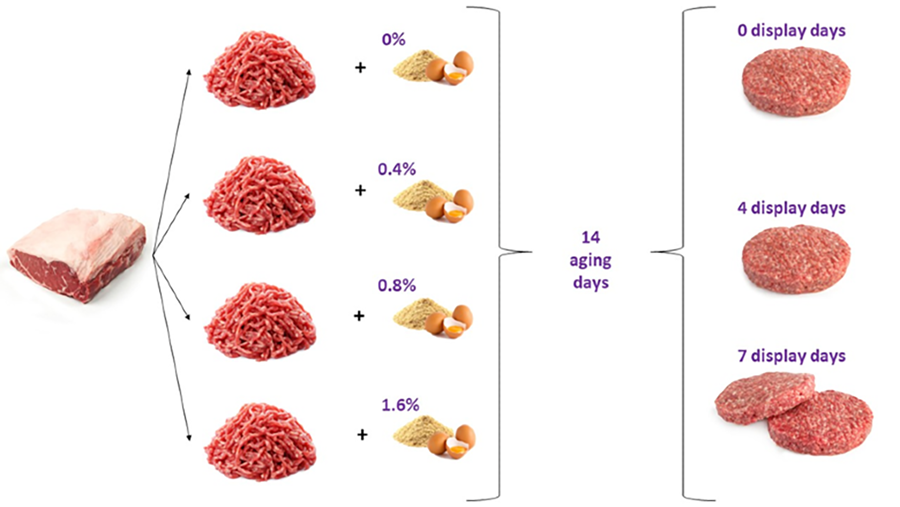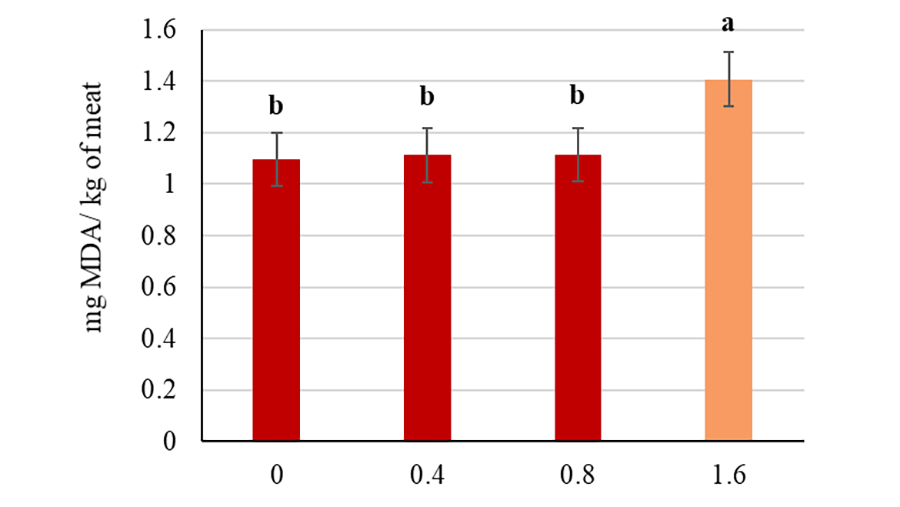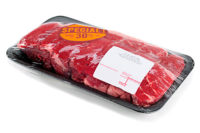Fresh beef has a relatively short shelf-life due to beef lipid’s susceptibility from attacks of free radicals and thus resulting in lipid oxidation. Previous studies have demonstrated that lipid oxidation is enhanced by the hydrolysis of phospholipids by an enzyme known as phospholipase α2 (PLA2) in beef. Anti-phospholipase α2 (aPLA2) is an antibody that has shown to inhibit PLA2 activity, and aPLA2 can be mass-produced in eggs from hens immunized against PLA2. The resulting eggs can be spray- or freeze-dried into egg powder (EP) to preserve the antibody activity. Perhaps, incorporating aPLA2 into ground beef patties may be able to extend fresh beef shelf-life by delaying lipid oxidation.
To test this hypothesis, vacuum-packaged USDA choice striploins from 10 different beef carcasses were obtained from a beef packing plant at 2 days postmortem. The next day, each loin was ground, divided into 4 batches, hand mixed with 0, 0.4, 0.8, or 1.6% of dried EP containing aPLA2 (w/w), vacuum packaged, and stored at 35.6 °F for 14 days. After the storage period, each batch of ground beef was formed into four 0.25 lb patties, overwrapped, and randomly assigned to 1 of the 3 retail display periods (day 0, 4, and 7; Figure 1). Moisture content, protein content, fat content, fatty acid (FA), and phospholipid profiles were measured from samples on day 0 of the simulated retail display across the 4 EP treatments. Percent visual discoloration was determined using a trained panel, and L* (lightness), a* (redness), and b* (yellowness) of the patties were determined using a colorimeter on each day of display for all EP treatments. Finally, lipid oxidation status, antioxidant capacity, and pH were measured on samples from retail display periods of 0, 4, and 7 days across the 4 EP treatments.

As expected, a* and b* values decreased, and visual discoloration increased for all treatments throughout the seven days of retail display. However, the inclusion of EP had no effect on beef patty visual discoloration, a* or b*. Onward with the chemical changes, an expected increase in lipid oxidation was observed as days in display increased, and there was also an increase in lipid oxidation for the 1.6% EP treatment when compared to those from the other 3 treatments (Figure 2). Although the findings of aPLA2 EP’s lack of color preservation effect and the higher lipid oxidation for those from the 1.6% EP treatment were unexpected, the FA and phospholipid profile analysis were able to shed light on some possible answers.
The addition of EP in the samples increased the relative percentage of trans vaccenic acid (trans-18:1), linoleic acid (18:2), eicosenoic acid (20:1), and docosahexaenoic acid (22:6). This inherent greater concentration of unsaturated FA in the EP could explain the cause of higher lipid oxidation of those from the 1.6% EP treatment when compared to the 0% treatment (control).

Furthermore, phospholipid profile analysis showed that there was not enough PLA2 activity in the samples for the hydrolysis of phospholipids. Enzymes are highly dependent on pH and substrate availability to function properly, and PLA2 prefers cleaving off linoleic acid (18:2) and arachidonic acid (20:4) from phospholipids. As beef cattle are ruminant, which goes through biohydrogenation to convert unsaturated FA into saturated FA in the rumen, there might not be enough unsaturated FA to serve as substrate for the PLA2 to be relevant in the beef system.
The proximate analyses showed no difference for samples from the EP treatments in protein or lipid content, but a decrease in moisture content was observed for those from the 1.6% EP treatment. Finally, a slightly higher hydrophilic antioxidant capacity was observed in the 0.8% treatment when compared to those from the 0% treatment.
The findings of this study conclude that adding EP containing aPLA2 to ground striploin affects the moisture content, FA profile, phospholipid composition, lipid oxidation, and antioxidant capacity, but has no impact on meat color preservation/shelf-life extension in the beef system. Other studies have shown that aPLA2 may play a stronger role in pork or fish; therefore, more research is needed to better understand the role of aPLA2 and PLA2 in red meat shelf-life.
References:
Velasco Ayala, C., Koulicoff, L. A., Chun, C. K., Boyle, E. A., O'Quinn, T. G., Richards, M. P., Jones, C. & Chao, M. D., (2023) “Exploring the Effects of Incorporating Egg Powder Containing Phospholipase α2 Antibody on Ground Striploin Shelf-Life”, Meat and Muscle Biology 7(1): 16242, 1-11. doi: https://doi.org/10.22175/mmb.16242




Report Abusive Comment